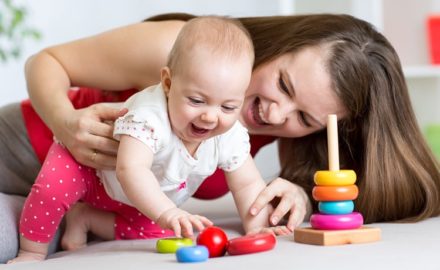
By: Elizabeth Wotherspoon
Have you ever wondered why learning language seems so easy for some kids and so hard for others?
Learning language is partly innate (it naturally develops as we grow), and it’s partly developed through experience. You may be thinking here that the kid who knows every name of every country must be well travelled. That may not be the case as children learn language through play!
Oh no, now you’re thinking you have to go out and buy all the fanciest games and toys that target learning. Please don’t!
I’m going to share some tips on how to use the toys you (probably) already own to stimulate language growth in your little one!
General “Rules” For Play
I was the youngest child in my family and I always wished someone, anyone would play with me! I would ask my brother and sister, my mom, anyone! So, if you want to use play to teach language, here is a list of some things to start doing anytime you play with your child to enure they are truly captivated:
- Get on their level (yep, on the floor!)
- Copy what they are doing.
- Model what they could do with the toys.
- Use short phrases (depending on your child’s level. If they are using one word, use two; if they say 2-3 words at a time, you say 3 – 4 words at a time.)
- Add something to your child’s language. For example, Timmy says, “blue” add one word by saying, “blue bird.”
- Don’t expect perfection. If your child says something that sounds like a word, give them credit!
- Watch what your child is doing and wait for them to say something. If they don’t, narrate their activity, as they may need to hear the words many, MANY times before saying them.
These strategies can be used while playing with absolutely anything. But, if you want a little more guidance, read on as I talk about how to play with the infamous kitchen set.
How To Build Language With A Play Kitchen
Just think of ALL the words that go with this set. It’s endless (almost) – hungry, thirsty, plate, cup, apple, strawberry, lettuce, hotdog, ketchup, juice, etc.
So, while your child is learning all the language associated with food, here are some things you can be doing:
- Each dish will be a colour – a great way to add a word (“green cup”.)
- Count the dishes.
- Sort the dishes by colour, by category (plate, bowl, cup, etc.)
- Pretend to wash and put away the dishes, to cut and cook food, to eat the food you made.
- Make sounds effects:
- “mmmm, yummy!”
- “rumble, rumble” when boiling water
- “gulp gulp” when pouring/drinking a drink
- “swish” when flipping a pancake
Is That It?
I like to think I was pretty good at playing when I was young. But, when my mom FINALLY agreed to play with me, it was almost always boring!
This may be because I could tell she wasn’t really enjoying herself. Or, it could be because she always wanted to play in the same way. Don’t get me wrong, children like to play one activity in the same way over and over (just like how they like to read the same story.) This helps them learn! But, there does come a point when enough is enough and they become bored of the same old thing.
So now what’s the play kitchen good for? Switch up the activities and it’s like a whole new toy! Play food, dishes and a kitchen can be used in so many ways; here’s a few possibilities:
- Prepare and go for a pretend picnic.
- Make a shopping list and hit up the “grocery store” (all the food lined up in your living room.)
- Invite others (stuffed animals, mom or dad, grandma or grandpa) over for a dinner party.
- Play restaurant taking turns being the server and the customer.
Your Time to Shine
Now it’s time for you to go play with your child with confidence! Think about what works and how you can use that next time.

